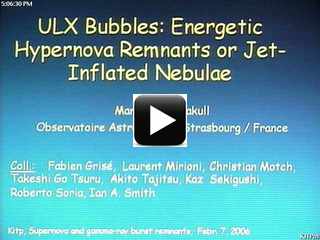An interesting result from the optical study of ultraluminous (i.e. L_x
10^39.5 erg/s) variable X-ray sources in nearby galaxies has been the
discovery of huge (several hundred pc diameter (!)) bubble-like emission
nebulae surrounding these objects. From the measured line widths
(corresponding to ~ 100 km/s) and diagnostic emission-line ratios
(e.g. [OI]6300/H_alpha > 0.3) we find that these ULX bubbles are young
(<10**6 yrs), largely shock-excited structures, although there is also
evidence for contribution from (X-ray) photoionisation close to the
sources. Using SUBARU, ESO-VLT and HST photometry of the recently
identified underlying poor star clusters to which the ULXs belong, stellar
isochrones yield cluster ages of some 20--60 Myrs proving that the stellar
population is much older than the ULX bubbles.Straightforward application of adiabatic SNR or wind-bubble dynamics, plus
an estimate of the interstellar density from the observed recombination
line luminosity of radiative shocks, yields ULX bubble energies of some
10^53 erg. This is much larger than the kinetic energy of a single SNR, and
more than the superbubble history from the cluster could have possibly
provided during its entire lifetime, let alone during the past 10^6 yrs.Taking into account the effects of a clumpy, rather than uniform ISM and of
expansion of the shocks into previously excavated stellar wind
bubbles, the energy requirements could be lessened by a factor of
ten. This is still much higher than the 10^51 erg kinetic energy of a SN
explosion, but is comparable to what has been claimed for
\"hypernova\" remnants. However, inspired by the properties of the famous
SS433/W50 system and the largely \"dark jets\" from galactic black hole
binaries, I will present evidence for ongoing inflation of ULX bubbles by
relativistic jets emanating from the presumed accreting black holes in
ULXs.Finally, our optical search for nebula around ULXs that are currently X-ray
inactive, or that are possibly beamed away from our line-of-sight, has
revealed at least one very large (> 200 pc diameter) [OI]6300
bright, i.e. shock-excited, nebula in the nearby spiral NGC~1313. We will
discuss these results in the light of current knowledge of past and ongoing
energetic input of black-hole binaries into the ISM.
 Other video options
Other video options
To begin viewing slides, click on the first slide below. (Or, view as pdf.)
![[01]](tn/01.jpg)
![[02]](tn/02.jpg)
![[03]](tn/03.jpg)
![[04]](tn/04.jpg)
![[05]](tn/05.jpg)
![[06]](tn/06.jpg)
![[07]](tn/07.jpg)
![[08]](tn/08.jpg)
![[09]](tn/09.jpg)
![[10]](tn/10.jpg)
![[11]](tn/11.jpg)
![[12]](tn/12.jpg)
![[13]](tn/13.jpg)
![[14]](tn/14.jpg)
![[15]](tn/15.jpg)
![[16]](tn/16.jpg)
![[17]](tn/17.jpg)
![[18]](tn/18.jpg)
![[19]](tn/19.jpg)
![[20]](tn/20.jpg)